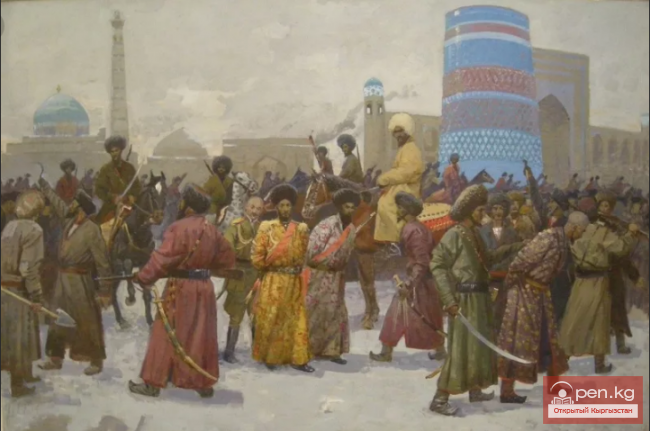Mamyr Mergenov — a man of humble origins
The scattered uprisings of the rebels covered new areas of the Khanate, especially the southern part of Kyrgyzstan. The fight against feudal and khan oppression was joined by the ichkiliks, adyghines, tagays, munduzs, kushkas, bagyshs, basyms (kamans), karabagyshs, kytays, and several other Kyrgyz tribes and clans, as well as a significant part of the Kipchaks and the neighboring Uzbek population.
In the spring of 1873, Kyrgyz nomads from the Andijan province rose up. They were led by 36-year-old Mamyr Mergenov — a man of humble origins. According to archival sources, Mamyr Mergenov, unwilling to pay taxes to the khan's government, sought to defend this desire by force and, gathering a band (a detachment of rebels — K.U.) of Kyrgyz, launched an attack on representatives of the khan's authority. Initially, the rebels, led by Mamyr, acted successfully. They managed to capture the city of Khanabad. However, in a battle near Janabad, the rebels were unable to achieve victory over the punitive forces, although they inflicted serious damage on them. The insurgents lost 300 men killed.
Many wounded remained on the battlefield. There were also many prisoners, who were distributed among the kishteks in groups of 5-7 people, and the barbaric punishments included impalement. By the order of Khudoyar Khan, "women and children were killed, and pregnant women had their bellies cut open!" Such atrocities by the punitive forces further hardened the rebels.
A part of the rebels (1700 families) fleeing from the pursuers escaped to the high mountainous areas in Toguz-Toro and Ketmen-Tube within the Tokmak district of the Semirechye region of the Turkestan Governor-Generalship, i.e., within Russia. Khudoyar Khan appealed to the representatives of the colonial authorities to return these refugees — the Kyrgyz. Additionally, Abdurakhman Aftobachi attempted to retrieve the refugees by gifting valuable presents to their elders. Some of the rebels, on the recommendation of the tsarist officials, indeed returned. But they were immediately robbed by the khan's officials and forced to flee again to where they had come from, especially to Kögmen-Tube. The khan's officials managed to capture about 60 refugees, who were tortured in dark, damp sheds. The refugees did not surrender voluntarily. In clashes with the punitive forces, both sides suffered significant losses. 40 rebels and 15 khan's soldiers were killed.
Mamyr Mergenov, with a hundred loyal rebels, retreated to the mountains in the eastern part of the khanate for the winter — to the pastures of the adyghine tribe. By spring, he moved to the Toguz-Toro area with the aim of rallying the local Kyrgyz for a common struggle against Khudoyar Khan, but without much success. In doing so, he took all measures to intensify the fight against feudal and khan oppression and to attract as many supporters as possible, while also trying to secure help and support from Russia. It is no coincidence that in the spring of 1874, Mamyr appealed to the Turkestan administration with a request to accept him as a Russian subject. However, the local tsarist authorities, who were fully supporting Khudoyar Khan and his allies, did not respond to Mamyr's request. Therefore, pursued by the khan's punitive forces, Mamyr moved to Kashgar, hoping to gain support from the local Kyrgyz population in the fight against the Kokand rulers. He continued to prepare for a new, more powerful uprising.
Punitive Operations of Khudoyar Khan Against the Rebels in 1873












































